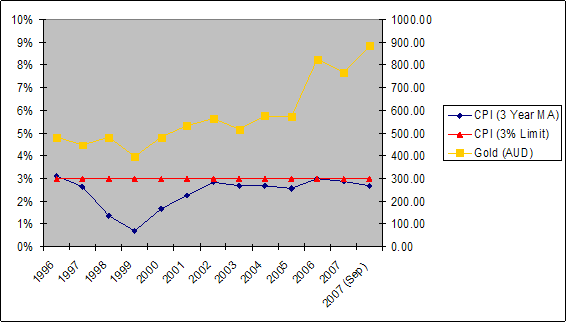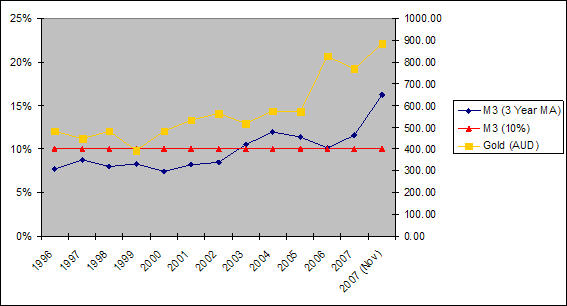Could Inflation Explain the Rise in Gold Prices?
The following is an extract from the December 07 Issue of The Global Speculator sent to subscribers on the 4th of January 2008.
As the gold price recently made all time historical highs in terms of US dollars, many have been left scratching their heads as to why the explosive movement. Explanations ranging from political unrest in the Middle East to shrinking production levels from South Africa have been bandied around. Other reasons have included strong investment demand from the Middle East and Asia as well as market turmoil surrounding the credit markets. Finally that ugly word inflation which has been essentially missing for the last 15-20 years is beginning to be entertained, despite headline CPI numbers consistently within the Reserve Bank of Australia's (RBA) comfort zone (<3%). The gold price in Australian dollars has been rising continuously from its bear market lows of AUD$395 in 1999 to its present record level of over AUD$1000 an ounce. Assuming CPI is an accurate gauge of inflation, one couldn't be blamed for concluding that inflation is perhaps a poor explanation for gold's stellar performance. The chart below demonstrates that the RBA has been largely successful in maintaining CPI below its upper limit of 3%.

Data Source: Reserve Bank of Australia
Many financial analysts in the media have long argued that the price of gold is a poor inflation gauge and looking at the chart above it is difficult to disagree with them. Perhaps the earlier stated reasons of political unrest, shrinking South African supply and increasing demand from the Middle East and Asia may provide more appropriate explanations. What's say we return to the inflation line of reasoning however and think outside the square for a moment? Perhaps we need to look no further than the effectiveness of CPI in measuring inflation? Perhaps this is the problem and the gold price remains an excellent inflation gauge after all. I would like to now logically explore this possibility in more detail with a brief Question and Answer session.
1. By definition "What is Inflation?"
That's easy. At university I was taught Keynesian Economics and that is inflation is an increase in the price of some set of goods and services in a given economy over a period of time. It can be measured as the percentage rate of change of a price index. This price index is commonly called the CPI. Great, but this leads us to another important question:
2. Generally speaking what causes prices to increase?
As an economy grows, demand for goods and services can increase at a greater rate than the rate of production of these goods and services causing prices to rise. A case in example would be the dramatic cost increases in Australia's booming mining industry. Fair enough.
3. What causes economic growth?
Economic growth is primarily driven by private sector investment into productive business which generates goods and services consumers and other businesses demand. This increased investment creates jobs where people earn money which they then have the choice of either saving, investing or spending. Saving and investment assists in further growing the economy, whereas consumption does not.
4. Couldn't you argue consumption does grow the economy in that you need someone to purchase the goods and services that are being provided?
Consumption is an important part of a thriving economy, but consumption in itself does not grow an economy. You can only generate sustainable economic growth via increased business investment. This in turn creates more jobs and more disposable income which can then be saved, invested or spent. China is a good example of an economy where domestic consumption takes up a very small proportion of what is actually produced. Domestic savings are high and China continues to achieve double digit economic growth.
5. Why then can we experience a general increase in prices during economic growth?
By our present logic investment comes first which generates earnings before consumption can even take place (the chicken before the egg). If this is broadly true, how can demand exceed overall supply causing prices to increase? The answer is quite simple. Businesses and consumers do not only have earnings and savings to invest or consume but also have access to borrowed money (credit).
6. What happens if consumers on large do not only spend what they earn but also buy many things on credit? Surely this grows the economy?
Well yes and no. Existing business may benefit in the short to intermediate term and invest in productive capacity to cater for this additional credit induced demand. This will filter through into economic growth but only for as long as consumers can continue borrowing money to spend. The act of borrowing and spending in itself does not grow an economy.
7. Could one then argue economic growth fueled by credit may in effect be artificial in nature?
One could definitely make a strong case for this as credit markets do not always accommodate ongoing consumer and business borrowing. Unlike our former scenario where consumers spent savings derived from their wages, economies that become increasingly dependent on credit induced consumption become susceptible to adverse changes in the credit markets (higher interest rates).
8. What does this have to do with rising prices and inflation?
When economic growth becomes increasingly dependent on credit, the requirement to produce first to generate earnings and savings is largely diminished. Simplistically, consumers do not need to earn the money by producing something first, they just borrow to purchase things. This can result in an increase in demand for goods and services without the required increase in productive capacity to supply them, leading to general price rises.
9. If this is the case could one not argue that inflation is not a rise in prices but an increase in the level of cheap available credit?
Now we are getting somewhere. When you introduce credit into an economy and make the terms attractive for long enough, the prices of goods and services will generally rise. It would seem that inflation by definition is not higher prices as the CPI implies but easier credit conditions (inflated money supply). Attempting to prevent inflation using CPI as an indicator is akin to trying to prevent a cold/flu by treating the symptoms once you have already been infected. The virus is already in your system as are the vast amounts of credit in the financial system at the present time. The monetarists view inflation as too much money (including credit) chasing too few goods, and what results is higher prices. The cure is either to reduce the money and credit, or increase the amount of goods.
10. Rather than measuring inflation via CPI which seems very reactionary, would you not be better off monitoring the risk of inflation via the levels of credit growth?
Measuring inflation via CPI (price increases) can be very hit or miss because unless you are monitoring those goods and services chiefly affected, you can very easily miss it, especially in the early stages. House prices in Australia have been the major beneficiary of an easy monetary policy by the RBA over the past decade. Many home loan customers over the last 7-8 years were not even required to save a deposit in order to buy a home (1st home owners grant), which in turn aided in the affordability of housing. House prices are not included in headline CPI, hence this is an obvious example of inflation that was missed. Domestic price increases may also be masked via the offsetting effect of cheap imports from overseas. The fact that one may offset the other in the compilation of CPI doesn't change the fact that prices are increasing sharply in some areas (food and energy).
M3 money supply is a statistic that is commonly used to track the amount of money in circulation including credit. Historically, when M3 growth consistently exceeds 10% pa the risk of higher prices increases exponentially. The 1970's and 80's were an excellent example of this with M3 growth rates averaging 13.3% pa over the period of 1970-1989. Credit is the major driving force of M3 growth. If we revisit a comparison of the gold price measured against a 3 year moving average (MA) of annual M3 growth, we can see a much stronger relationship. The 3 year MA has exceeded 10% since 2003 in line with the acceleration in the price of gold in Aussie dollars.

Data Source: Reserve Bank of Australia
This financial year to date has seen an annualized rate of M3 growth exceeding 25% pa as the RBA intervenes to ease credit constraints. A growth rate this high has only ever been achieved twice in Australia over the past 40 years. Those years were 1973 (25.67%) and 1989 (27.92%). What followed were two very deep recessions.
The Austrian School of Economics has long defined inflation as simply an increase in the supply of money. The gold price has historically been one of the best gauges of inflation due to its fairly constant supply (averaging 1.7% pa for the last 30 years - Source: United Nations). When we look at the two charts above we see that one clearly explains the increasing gold price where the other does not. Unfortunately history has proven that by the time inflation manifests itself broadly across prices, it becomes very difficult to contain (1970's and 1980's). The last time central bankers fought inflation it took a prolonged period of double digit interest rates to mop up the excess liquidity and return price stability. With Australian household debt at all time highs, one wonders if the RBA will have the luxury of prescribing such a remedy this time around without some pretty nasty side effects.
Troy Schwensen
The Global Speculator
DISCLAIMER
This publication has been prepared from a wide variety of sources which the editor to the best of his knowledge and belief considers accurate. The editor does not warrant the accuracy of the information and forecasts contained in this publication. This information is provided for educational purposes and nothing written should be construed as a solicitation to buy and sell securities.
















